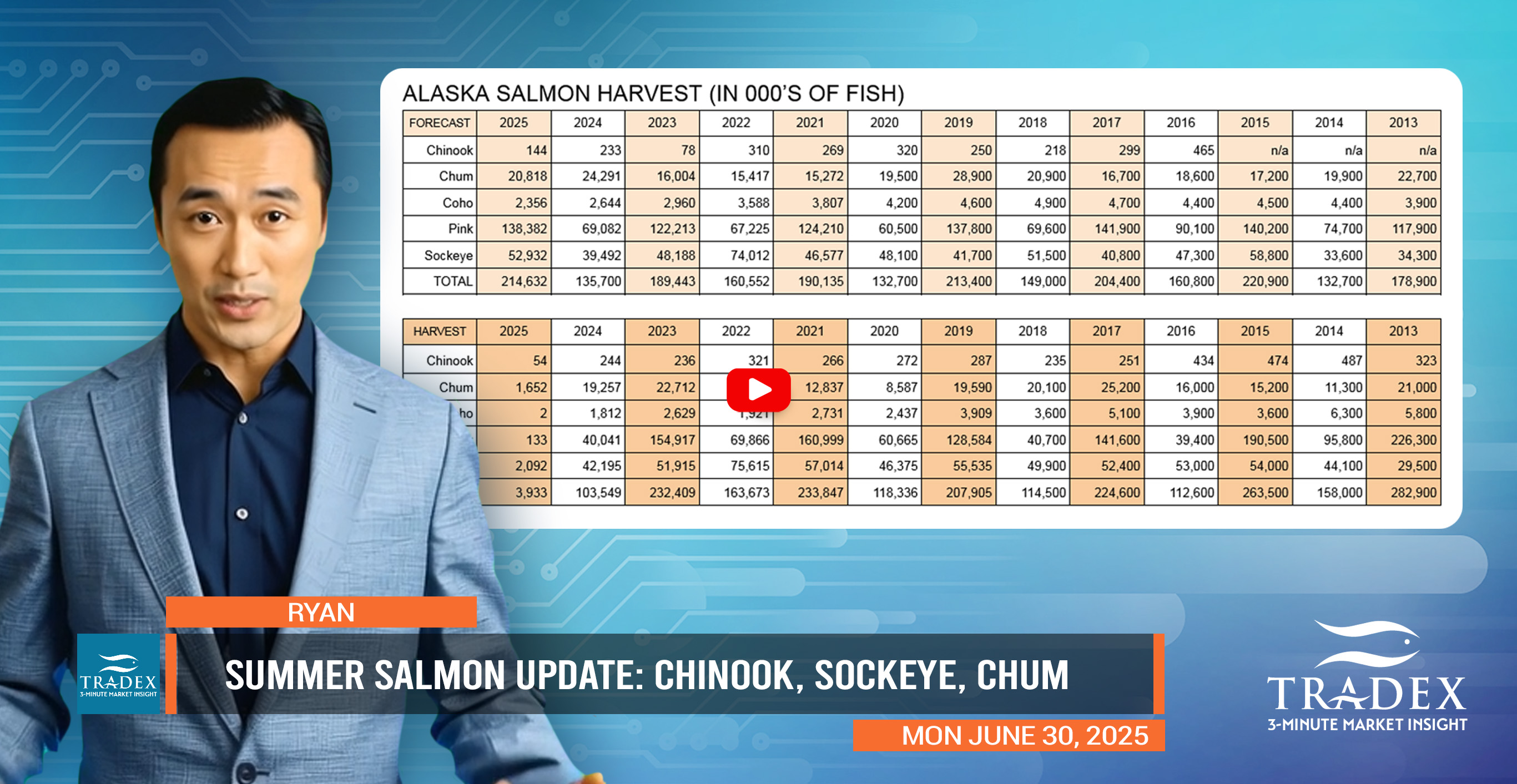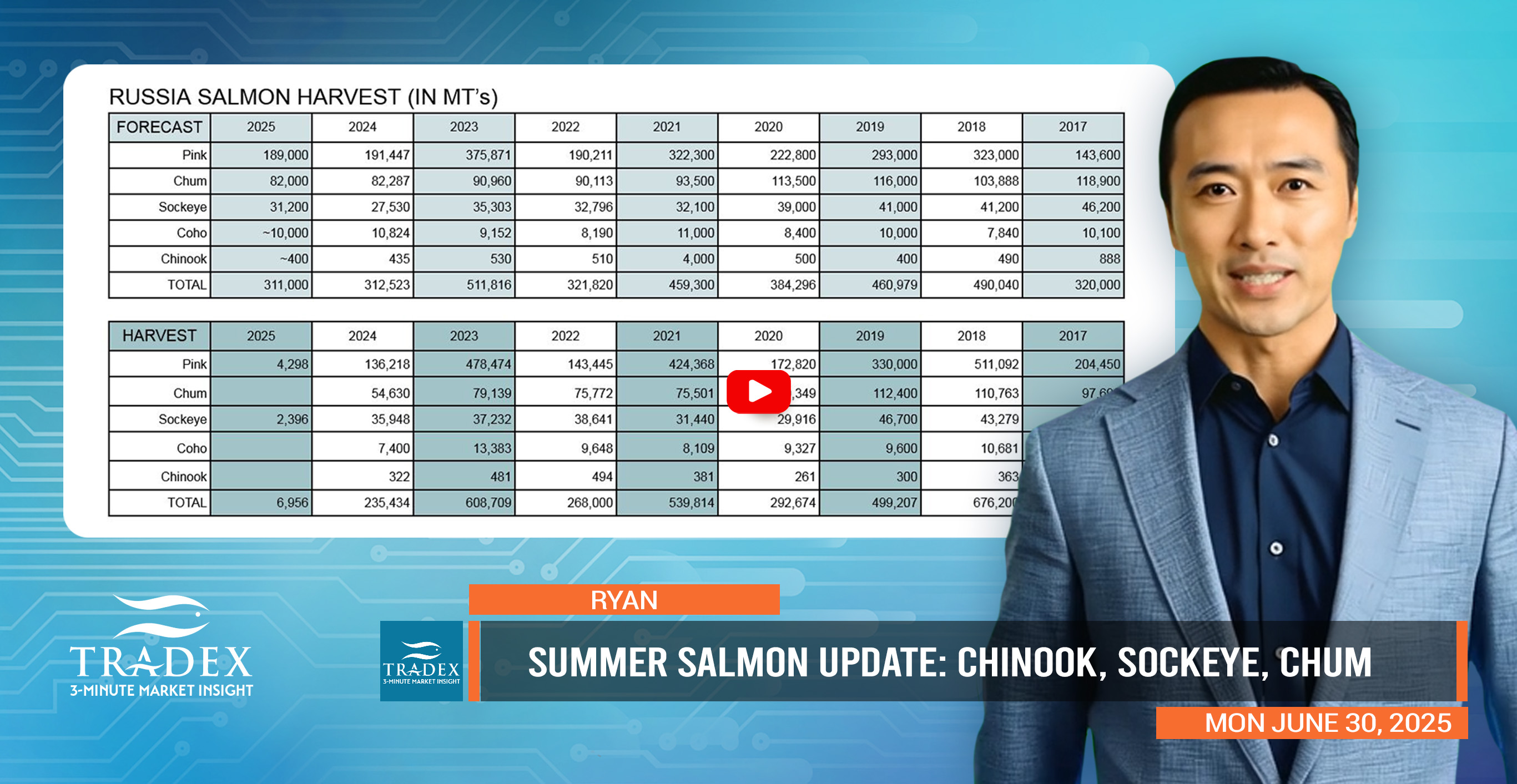
Loading
EP 747 | AIRED 06/30/2025
2025 Early Summer Salmon Update: Alaska Slow Start, Sockeye Leads Forecast, Global Supply Rebounds Amid Market Risks
June 30, 2025 - Alaska’s summer salmon season is underway and although we are still in the early stages of the season, late June landings across all species trails about a million fish compared to the same time last year, and 2.5 million salmon the last odd-numbered fishing year.
At the time of reporting, Alaska’s total commercial salmon harvest has exceeded 3 million fish, which is only 1.5% of the 214 million fish forecast for the season.
Chinook, Chum, and Sockeye are the first of the five Pacific salmon species to come out of Alaska each year. While initial volumes are lagging behind previous seasons, both Chum and Sockeye are showing signs of building momentum.
For Sockeye, Alaska dominates global sockeye production with a 5-year average of 125,000 metric tonnes, far ahead of Russia, the second-largest supplier at 35,000 metric tonnes. Most of Alaska’s sockeye harvest arrives in July, and the 2025 forecast is a robust 52 million fish—the second-highest since 2016. Since 2015, Alaska has harvested at least 90% of its sockeye forecast in every odd-numbered year, consistently exceeding 50 million fish. However, average fish size is down: in 2024, Alaska sockeye averaged 4.72 lbs, well below the 5-year average of 5.05 lbs. Russian sockeye averaged 5.04 lbs, in line with its historical norm.

For Chum, Russia leads global chum production with a 5-year average of 75,000 metric tonnes, while Alaska typically ranks third, depending on Japan’s fall harvest. Alaska’s chum landings are currently lagging, but typically peak in July, though the fishery is known for its unpredictability. In 2024, Alaska chum averaged 6.66 lbs, consistent with its 5-year average, while Russian chum were smaller, averaging 5.33 lbs.
For Chinook, Alaska’s 2025 Chinook forecast is the second lowest in over a decade, but actual landings have historically outperformed forecasts, averaging 275,000 fish annually (or 1500 metric tonnes). Although the U.S. is the top global producer of wild Chinook, Alaska is not always the top-producing state. Washington often matches or exceeds Alaska’s harvest, and when combined with Oregon, the two states produce nearly 70% more Chinook than Alaska on a 5-year average. In terms of size, Alaska Chinook averaged 11.31 lbs in 2024, slightly below average, while Washington and Oregon combined averaged 12.12 lbs.

Advertise Here: advertising@tradexfoods.com
Our recommendation is to act early on sockeye purchases but prepare for another year of small sizes; be strategic when securing chum salmon as supply is volatile; and prepare for another year of chinook supply similar to previous years.
Global wild salmon harvest this year could now exceed 800,000 metric tonnes, following a possible early-season revision by Russia adding 50,000 tonnes to its forecast, as reported by TASS and UCN. While this would represent a 50% rebound from last year’s record-low global harvest, it remains about 30% below the record high seen in the last odd-numbered year, when both Alaska and Russia posted record catches by volume and number of fish.

Although volumes are expected to recover from last year, ongoing sanctions against Russia will likely influence market pricing - depending on how the actual catch materializes.
Be sure to check out the weekly Alaska Salmon Catch Counter on TradexLIVE all throughout the summer salmon season.
This report is just one of many summer salmon reports so be sure to also subscribe to our 3-Minute Market Insight using the signup form or links below to keep tuned-in to the 2025 Salmon Season.
--- If you’re not already, be sure to subscribe to our 3-Minute Market Insight for seafood updates and insights delivered right to your inbox.


